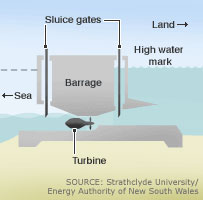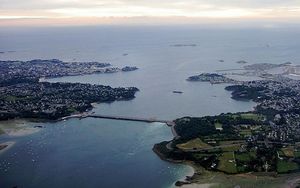Tidal barrage

Tidal barrage systems are a tidal power generation method that work similar to hydropower and have sluices that control the tidal flow to drive turbines and generate electricity.[2]
Benefits
These types of dams can be used not only to produce renewable energy, but also to reduce flooding. As the global effects of climate change becomes more evident, the world is faced with the very real threat of rising sea levels. Tidal barrages can be used to prevent flooding of low lying areas - areas that already are at a high risk of flooding - by holding back or releasing water as necessary.[3]
Furthermore, the Moon and Sun aren't going anywhere anytime soon (nor are their influence on the tidal forces) which means that we can easily produce this type of tidal power for as long as we need. This also means that tides are easily predictable and repetitive which allows us to know exactly when and how much power is attainable.[4]
Drawbacks
Tidal barrages alter the flow of saltwater in and out of estuaries, which can alter the quality of the seawater and thus negatively impact and displace marine life in the area.[3] Furthermore, barrage systems have high development costs and it can be difficult to justify using so much capital especially when the environmental threats are taken into consideration.
The other, perhaps obvious, problem with tidal power is that you need tides. It is important to think of tidal power not as a one-off solution for the world's energy needs, but rather, to see it as a contributor to a low-carbon electricity generation portfolio.
Barrage Designs
There are several different types and methods of producing electricity by tidal barrage. However, there are two main classes that are used. Typically the type or class used depends on the environmental circumstances of an area.[5]
Ebb Generation
Ebb generation uses gates that allow the water to fill a basin to the normal level, these gates are then closed at full tide. The water is then held back for a few hours while the tide recedes, the gates are then opened and the water flows through turbines for several hours generating electricity through to low tide.[6]
Two-way Generation
Two-way generation uses turbines to generate power during both flood and ebb tide. All the water flows through the turbines and, unlike ebb generation, the water is not held back but allowed to flow freely and constantly turn the turbines. The energy produced is usually less than ebb generation but electricity is produced over a longer period of time, which can be beneficial depending on what the energy requirements are for a specific area.[6]
Power Production

A great case study is the Rance Barrage (La Rance Barrage) - located in Brittany, France. It is the world's first tidal power station - and also has one of the highest capacities with a peak rating of 240 MW. Its annual output of approximately 600 GWh is lower than most traditional types of power plants such as nuclear or natural gas, however, the cost per kWh is comparable to other forms of sustainable energy.[7]
References
- ↑ Strathclyde University/Energy Authority of New South Wales
- ↑ Wyre Tidal Energy. (Accessed July 27, 2015). Tidal Barrage [Online]. Available: http://www.wyretidalenergy.com/tidal-barrage
- ↑ 3.0 3.1 EcoSpark. (Accessed July 27, 2015). Tidal [Online], Available: http://www.ecospark.ca/wattwize/students/tidal
- ↑ Keith Cooley. (Accessed July 27, 2015). The Moon and Tides [Online], Available: http://home.hiwaay.net/~krcool/Astro/moon/moontides
- ↑ KORDI Coastal Engineering Research Department. (Accessed July 27, 2015). Tidal and Tidal Current Power Study in Korea [Online], Available: http://www.energybc.ca/cache/tidal/KOREA.pdf
- ↑ 6.0 6.1 Zou Fan, University of Gavle. (Accessed July 27, 2015). Tidal Power Energy [Online], Available: http://www.exergy.se/goran/hig/ses/06/tidal.pdf
- ↑ 7.0 7.1 Wyre Tidal Energy. (Accessed July 27, 2015). La Rance Barrage [Online], Available:http://www.wyretidalenergy.com/tidal-barrage/la-rance-barrage

